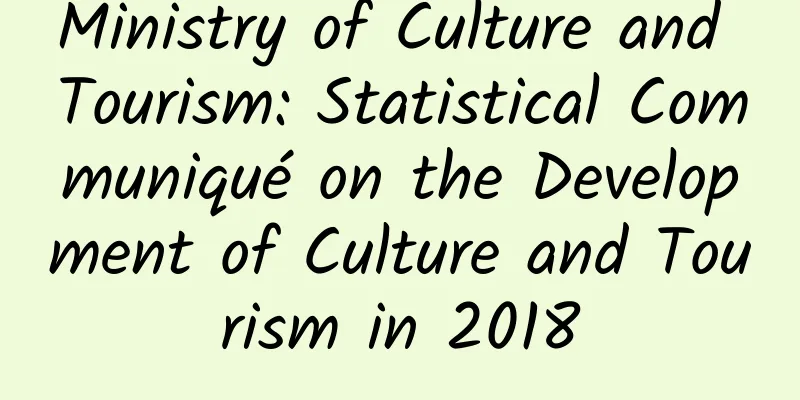Ministry of Culture and Tourism: Statistical Communiqué on the Development of Culture and Tourism in 2018

|
2018 is a crucial year for building a moderately prosperous society in all respects and implementing the 13th Five-Year Plan. The national culture and tourism system adheres to the guidance of Xi Jinping Thought on Socialism with Chinese Characteristics for a New Era, fully implements the spirit of the 19th CPC National Congress and the Second and Third Plenary Sessions of the 19th CPC Central Committee, closely focuses on the overall layout of "five in one" and the coordinated promotion of the "four comprehensive" strategic layout, strengthens the "four consciousnesses", strengthens the "four self-confidences", and achieves the "two safeguards", adheres to the general tone of work of seeking progress while maintaining stability, adheres to the people-centered work orientation, vigorously promotes the integrated development of cultural undertakings, cultural industries and tourism, and continues to prosper artistic creation, continuously improves the public service system, regulates and regulates market management, and maintains a good momentum of industrial development. The core socialist values and the excellent traditional Chinese culture are widely promoted, and the national cultural soft power and the influence of Chinese culture have been greatly enhanced. 1. Institutions and Personnel At the end of 2018, there were 318,200 cultural and tourism units of all kinds in the country, with 3,750,700 employees. Among them, there were 66,835 units affiliated to cultural and tourism departments at all levels, an increase of 91; and 670,600 employees, an increase of 3,400. 2. Artistic Creation and Performance In 2018, art troupes across the country continued to carry out the work of "going deep into life and taking root in the people", adhered to the people-centered creation orientation, established a sense of quality, and climbed to the peak of art. According to statistics on 400 key statistical art troupes across the country, a total of 1,150 artistic works were created and staged in 2018, including 802 new works, 260 re-staged works, and 88 transplanted and adapted works. The state-affiliated troupes have created works with great care, such as the Peking Opera "Red Army Story", the drama "Barcarolle", the fairy tale ballet "Nine-Colored Deer", and the symphony concert "Pudong Symphony". Among them, the newly created national opera "Liu Sanjie" shows the green mountains and clear waters of Guilin in the form of stage art, which has become a beneficial attempt to promote the integration of culture and tourism. The National Stage Art Creation Support Project was launched, and experts were organized to polish and improve the 25 selected plays. The Western and Ethnic Minority Regions Art Creation Promotion Plan and the Chinese National Opera Inheritance and Development Project were implemented, and the revitalization of opera, the Chinese Peking Opera Audiovisual and Script Support Project, and the Opera Script Incubation Plan were steadily promoted. The "Times Symphony-China Symphonic Music Creation Support Plan" was launched, and the "Theme Song +" creation and field trip activities were carried out. The "Lyrical New Era-Celebrating the 40th Anniversary of Reform and Opening-up New Song Concert" was organized and created. We successfully organized the gala "Our Forty Years" to celebrate the 40th anniversary of reform and opening up, and carefully organized a series of art activities such as the 2018 National Stage Art Excellent Repertoire Exhibition and National Excellent National Opera Exhibition, National Excellent Realistic Stage Art Works Exhibition (Tour), National Grassroots Theater Troupe Opera Festival, National Art Theater Troupe Performance Season, and National Art Museum Collection Exhibition Season, to showcase outstanding artistic achievements. During the New Year's Day and Spring Festival, we carried out a series of activities such as "Culture, Science and Technology, and Health Going to the Countryside", "Our Chinese Dream - Culture Entering Thousands of Homes", and "Culture Welcomes the Spring, Art for the People - Artists from the Ministry of Culture and Tourism Visit the Grassroots". The National Art Fund established 944 general funding projects and 16 rolling funding projects, with a total funding of approximately 760 million yuan, effectively playing the role of an incubator to promote the creation of excellent works and the growth of outstanding talents. At the end of the year, there were 17,123 art performance groups nationwide, an increase of 1,381 from the end of the previous year, and 416,400 employees, an increase of 13,400 from the end of the previous year. Among them, there were 2,078 art performance groups affiliated with cultural and tourism departments at all levels, accounting for 12.1%, and 114,400 employees, accounting for 27.5%. Throughout the year, art performance groups across the country performed 3.1246 million shows, an increase of 6.4% over the previous year, of which 1.7882 million were performed in rural areas, accounting for 57.2% of the total performances; the number of domestic audiences was 1.376 billion, an increase of 10.3% over the previous year, of which 779 million were rural audiences; the total income was 36.673 billion yuan, an increase of 7.2% over the previous year, of which the performance income was 15.227 billion yuan, an increase of 3.1%. Throughout the year, art performance groups affiliated with cultural and tourism departments across the country organized a total of 161,600 government-purchased public welfare performances, with 128 million audiences, an increase of 2.7% and 0.3% over the previous year respectively. 118,000 performances were performed using mobile stage vehicles, with 95 million audiences, an increase of 1.6% and 0.2% over the previous year respectively. At the end of the year, there were 2,478 art performance venues nationwide, 23 more than at the end of the previous year. The number of seats was 1.9204 million, up 6.9% from the previous year. A total of 178,900 art performances were held throughout the year, a decrease of 15.5%; the number of art performance audiences was 58.62 million, down 8.2% from the previous year; and the income from art performances was 3.744 billion yuan, down 13.5% from the previous year. Among them, there were 1,236 art performance venues affiliated with cultural and tourism departments at all levels, 17 fewer than the previous year. A total of 60,200 art performances were held throughout the year, down 15.2% from the previous year; the number of art performance audiences was 25.88 million, down 4.6% from the previous year. At the end of the year, there were 528 art galleries nationwide, 29 more than at the end of the previous year, and 4,744 employees, an increase of 168. A total of 7,021 exhibitions were held throughout the year, up 3.9% from the previous year, and the number of visitors was 37.21 million, basically the same as the previous year. III. Public Service System In 2018, we further implemented the Law of the People's Republic of China on Public Cultural Service Guarantee and the Law of the People's Republic of China on Public Libraries, carried out supervision on the implementation of the Law on Public Cultural Service Guarantee, and effectively promoted the implementation of the law and various reform measures. The National Ancient Books Protection Project was further promoted, and the Global Chinese Books Integration Project, the Chinese Medical Collection, and the Chinese Taoist Collection were confirmed and launched. We promoted local governments to carry out the construction of county-level cultural centers and library branch systems and the reform of the corporate governance structure of public libraries and cultural centers in areas with conditions according to local conditions. We carried out special governance of township comprehensive cultural stations, completed the acceptance of the third batch of national public cultural service system demonstration areas (projects), the creation of the fourth batch of national public cultural service system demonstration areas (projects), and the sixth national county-level and above public library assessment and grading work, and continuously improved the effectiveness of public cultural services. We promoted the construction of the National Public Cultural Cloud and improved functions such as shared live broadcast, resource on-demand, and big data analysis. We continued to carry out training for grassroots cultural teams across the country, with more than 500,000 people trained. We vigorously carried out the work of bringing opera into rural areas, and distributed 77,094 art performances to 12,984 townships in national poverty-stricken areas. We organized national square dance performances, with a total of 6,225 performances, 64,564 participating teams, 2.094 million participating people, and more than 42.06 million people watching. We held the 7th China Farmers' Song Festival and the 9th China Children's Chorus Festival, and launched the "Songs Accompany Me to Grow Up" national collection and promotion of the fifth batch of newly created children's songs. We continued to carry out the "Spring Rain Project", "Sunshine Project" and "Dream Project" cultural volunteer service activities for old revolutionary areas, border areas, ethnic areas and poverty-stricken areas. We held "Cultural Warmth" consolation performances to guide and drive all localities to increase the protection of the cultural rights and interests of special groups. We pragmatically promoted the toilet revolution, and made steady progress in the construction of the toilet revolution, technology application, management system innovation and civilization improvement actions. (I) Public Libraries At the end of the year, there were 3,176 public libraries across the country, 10 more than at the end of the previous year. At the end of the year, there were 57,602 public library employees across the country, 35 more than at the end of the previous year. Among them, 6,632 people have senior professional titles, accounting for 11.5%; 18,622 people have intermediate professional titles, accounting for 32.3%. At the end of the year, the actual building area of public libraries in China was 15.9598 million square meters, an increase of 5.3% over the end of the previous year; the total collection of books was 1,037.16 million, an increase of 7.0% over the end of the previous year; the number of seats in the reading room was 1.1168 million, an increase of 4.9% over the end of the previous year; there were 223,500 computers, of which 146,300 were electronic reading terminals for readers, which were basically the same as the previous year. At the end of the year, the average building area of public libraries per 10,000 people was 114.4 square meters, an increase of 5.4 square meters over the end of the previous year; the national per capita book collection was 0.74 books, an increase of 0.04 books over the end of the previous year; the national per capita book purchase expenditure was 1.77 yuan, an increase of 0.07 yuan over the end of the previous year. Throughout the year, 72.63 million library cards were issued by public libraries nationwide, an increase of 7.8% over the previous year; the total number of circulations reached 820.32 million, an increase of 10.2%. 580.10 million books and periodicals were loaned out, an increase of 5.3% over the previous year; the number of borrowers reached 258.14 million, an increase of 1.2% over the previous year. Throughout the year, 179,043 activities were held for readers, an increase of 15.1% over the previous year; the number of participants reached 106.48 million, an increase of 20.2% over the previous year. (II) Mass cultural institutions At the end of the year, there were 44,464 mass cultural institutions nationwide, a decrease of 57 from the end of the previous year. Among them, there were 33,858 township comprehensive cultural stations, a decrease of 139 from the end of the previous year. At the end of the year, there were 185,637 people working in mass cultural institutions nationwide, an increase of 4,726 from the end of the previous year. Among them, 6,386 people had senior professional titles, accounting for 3.4%; and 17,245 people had intermediate professional titles, accounting for 9.3%. At the end of the year, the actual floor area of mass cultural institutions in China was 42.8309 million square meters, up 4.3% from the end of the previous year; the floor area of business premises was 31.4617 million square meters, up 5.7% from the end of the previous year. At the end of the year, the average floor area of mass cultural facilities per 10,000 people was 306.95 square meters, up 11.51 square meters from the end of the previous year. Throughout the year, mass cultural institutions across the country organized 2.1948 million cultural activities of various types, up 10.9% from the previous year; the number of people served was 705.53 million, up 10.3% from the previous year. At the end of the year, there were 7,990 cultural groups run by cultural institutions across the country, with 163,000 performances and 83.12 million audiences. There were 426,100 amateur cultural groups guided by cultural centers (stations), and 798 senior citizen universities run by cultural centers. IV. Management of the cultural and tourism market In 2018, we will further implement source control, support and guide cultural market operators to improve services and change their image, revise the "National Cultural Market Blacklist Management Measures" and "Tourism Market Blacklist Management Measures (Trial)", and study and formulate the "Guiding Opinions on the Implementation of the Tourism Service Quality Improvement Plan" and the "Interim Regulations on the Management of Online Tourism Business Services" to provide policy guarantees for improving quality and standardizing management. Nine administrative approval items such as travel agencies and amusement and entertainment venues are included in the "license and certificate separation" reform items of the State Council and promoted nationwide. The "Notice of the Ministry of Culture and Tourism on the Implementation of the Cultural Market Management Policy of the Free Trade Pilot Zone" was issued to support the free trade pilot zone and Hainan and other places to expand the opening of the cultural and tourism market. The national tourism supervision service platform was fully launched, and the level of intelligent supervision was further improved. Promote the issuance of the "Internet Access Service Business Venue Service Grade Assessment", carry out activities such as "Healthy Entertainment National Competition" and "Karaoke Sunset Red", and continuously deepen the transformation and upgrading of the cultural entertainment and online service industry, and promote the high-quality development of the industry. Tourism safety and holiday work have been steadily advanced. Focusing on key periods such as May Day, National Day, summer vacation, and flood season, we have intensified safety inspections and potential safety hazards investigations on travel agencies and A-level tourist attractions. At the end of the year, there were 237,100 cultural market operating units nationwide, 20,300 fewer than at the end of the previous year; 1,667,300 employees, 65,900 fewer than at the end of the previous year. Among them, there were 70,584 entertainment venues nationwide, 528,200 employees, annual operating income of 52.097 billion yuan, and operating profit of 11.233 billion yuan; there were 124,266 Internet access service business venues, 346,700 employees, annual operating income of 29.463 billion yuan, and operating profit of 7.676 billion yuan. The comprehensive law enforcement business capabilities have been continuously improved. The second national comprehensive law enforcement post training skills competition for the cultural market was held, and various online and offline training efforts were intensified. 13 training sessions of various types were held, nearly 30,000 people were trained online, and more than 600 online examinations were held. The National Cultural Market Technical Supervision and Service Platform was put into operation, and more than 97% of the provincial, municipal and county law enforcement agencies in the country officially used it. In 2018, 5.7083 million inspections were carried out through the platform, and 36,400 cases were handled. The application scope of the mobile law enforcement system was further expanded. 143 cities and prefectures across the country have put it online, and 42,000 inspections were carried out through the mobile law enforcement system, and 6,880 inspections of business units were carried out. The market law enforcement inspection and rectification efforts were intensified, and various special rectification actions were continuously carried out, focusing on the rectification of commercial performances, online performances, online music, online animation and other fields. The supervision of key cases in the tourism market was intensified, and more than 2,000 tourism-related complaints were handled. A total of 67,600 inspections were carried out on travel agencies and their branches across the country, 3,282 cases were filed, 34.81 million yuan of fines and illegal gains were confiscated, and 108 travel agency business licenses were revoked. Actively guide and promote the construction of the "1+3" comprehensive tourism market supervision mechanism. At present, 437 tourism police agencies, 344 industrial and commercial tourism sub-bureaus, and 554 tourism circuit courts have been established in various places. V. Utilization of Tourism Resources In accordance with the arrangements and deployments of the CPC Central Committee and the State Council on all-region tourism, we will earnestly implement the "Guiding Opinions of the General Office of the State Council on Promoting the Development of All-region Tourism", and in accordance with the "Guiding Principles for the Creation of All-region Tourism Demonstration Areas", we will solidly promote the creation of national all-region tourism demonstration areas, initiate the formulation of the "Implementation Measures for the Acceptance, Recognition and Management of National All-region Tourism Demonstration Areas (Trial)" and "National All-region Tourism Demonstration Area Acceptance Standards (Trial)" and other documents, continuously promote the in-depth development of all-region tourism, and accelerate the transformation and upgrading of the tourism industry, improve quality and increase efficiency. We will issue the "Guiding Opinions on Promoting the Sustainable Development of Rural Tourism" and the "Action Plan for Promoting the Quality and Upgrading of Rural Tourism Development (2018-2020)" to promote the sustainable and healthy development of rural tourism. We will strengthen the training of tourism talents in poverty-stricken areas, hold a total of 9 tourism poverty alleviation training courses throughout the year, train 2,000 people, and strive to improve the knowledge level and professional skills of key village cadres and tourism leaders in rural tourism. We will vigorously promote the development of leisure and vacation tourism, actively create effective leisure and vacation space to meet the rapid development of leisure and vacation tourism needs of Chinese residents, and organize and carry out the evaluation of national tourist resorts. We will continue to promote the development of TCM health tourism, and jointly with the State Administration of Traditional Chinese Medicine, announce the first batch of 72 national TCM health tourism demonstration base creation units. We will vigorously develop self-driving RV tourism, and accelerate the compilation of relevant industry standards for self-driving tourism. We will accelerate the development of new tourism formats such as hot spring tourism and ice and snow tourism. We will vigorously promote red tourism, hold a national red tourism five-good guide construction action promotion meeting, and carry out pilot work in some provinces. We will jointly organize the National Red Story Guide Competition with the Central Propaganda Department, carry out the "Gold Medal Guide Telling Red Stories" centralized display activity, and produce 100 short videos of red classic stories for centralized exhibition. We will carry out 6 red tourism demonstration trainings, and train more than 1,300 red tourism administrative personnel, scenic spot and travel agency leaders, key guides, and tour guides. We will coordinate and guide the development and publicity of the domestic tourism market, launch the "National Winter Tourism Promotion Season" in November 2018, and issue the "Notice on Doing a Good Job in the Supply of Winter Tourism Products". We will organize a symposium on winter tourism promotion and hold the "Winter Tourism Promotion Season Launch Ceremony and Northern Ice and Snow Theme Promotion Conference". Around the Yangtze River International Golden Tourism Belt Development Promotion Conference, the National New 5A-level Tourist Attractions Awarding Ceremony, China Tourism Industry Expo and other activities, the news media were organized to conduct concentrated coverage to expand the social influence of the activities. In 2018, the domestic tourism market continued to grow steadily, the inbound tourism market steadily entered a slow recovery channel, and the outbound tourism market developed rapidly. The number of domestic tourists in the whole year was 5.539 billion, an increase of 10.8% over the same period last year; the number of inbound tourists was 141.2 million, an increase of 1.2% over the same period last year; the number of outbound tourists was 149.72 million, an increase of 14.7% over the same period last year; the total tourism revenue for the whole year was 5.97 trillion yuan, an increase of 10.5% year-on-year. At the end of the year, there were 11,924 A-level scenic spots in the country, with a total number of 6.024 billion people received throughout the year, an increase of 10.5% over the end of the previous year, and tourism revenue of 470.754 billion yuan, an increase of 7.8% over the end of the previous year. VI. Industry and Technology In 2018, the Guiding Opinions on Promoting the Cooperation Model between Government and Social Capital in the Cultural Field was issued to further promote the transformation of government functions, innovate the cultural supply mechanism, and guide social capital to actively invest in the cultural field. Several Opinions on Improving the System and Mechanism for Promoting Consumption and Further Stimulating the Consumption Potential of Residents and the Implementation Plan for Improving the System and Mechanism for Promoting Consumption (2018-2020) were drafted, and the National Cultural Consumption Pilot City Award Plan was implemented to coordinate the promotion of cultural and tourism consumption. The 3rd Animation Award of the China Cultural and Art Government Award was organized, and 20 awards were selected to guide the direction of animation creation and encourage the development of original animation. Two digital art standards, "Application Scenarios, Frameworks and Metadata of Digital Artwork Image Display System" and "AR Demand and Application Framework for Cultural Relics/Artworks", were organized and formulated, and the projects were successfully established in the International Telecommunication Union, paving the way for my country's digital art industry to go global. At the end of the year, there were 809 animation companies jointly recognized by the Ministry of Culture and Tourism, the Ministry of Finance, and the State Administration of Taxation, including 43 key animation companies. We guided social capital to actively invest in the fields of culture and tourism. We jointly issued policy documents on promoting the cooperation between government and social capital in the fields of culture and tourism with the Ministry of Finance. We selected 66 cultural and tourism PPP (government and social capital cooperation) demonstration projects with the Ministry of Finance, and received 364 million yuan in "awards instead of subsidies". We implemented the "Cultural Industry Double Innovation Support Plan", selected and supported 40 cultural industry mass innovation spaces and double innovation service platforms, and built a double innovation service system for the development of private cultural enterprises and small and medium-sized cultural enterprises. We issued the "National Cultural Industry Demonstration Park Creation and Acceptance Standards (Trial)", clarified the indicators and specific contents of the creation and acceptance work, and further strengthened the standardization of the creation work. We organized and implemented the "National Cultural Industry Park Service Capacity Improvement Plan" and supported 15 national cultural industry parks' service capacity improvement projects. We deepened international cooperation in the cultural industry and promoted a higher level of opening up. We carried out the collection and support of key cultural trade and investment projects of the "Belt and Road" in 2018. The first batch of 40 key projects were supported, involving a total investment of about 4.2 billion yuan, and have been implemented in nearly 10 countries along the route. We held forums and policy dialogues on the cultural industries of China and Canada, China and Vietnam, and China, Japan and South Korea. We supported cultural enterprises to "go abroad in groups", and organized more than 200 cultural enterprises to participate in 9 major international cultural exhibitions such as the US International Licensing Expo in the form of "China Exhibition Area" throughout the year. We coordinated and organized a series of work such as investment promotion and exhibition attraction, travel guarantee, etc. in the cultural and tourism fields of the first China International Import Expo, supported the holding of supporting activities for the "Harmony and Resonance" Culture + Technology Summit Forum, and built a new platform for foreign exchanges and cooperation for enterprises. We strengthened the training and exchanges of international talents in the cultural industry, and trained nearly 2,000 foreign-related cultural management personnel through the holding of a series of forums for the China Cultural Products International Marketing Annual Conference. According to statistics from the National Bureau of Statistics, in 2018, 60,000 cultural and related industry enterprises above a certain scale achieved operating income of 8925.7 billion yuan, an increase of 8.2% over the previous year, and continued to maintain a relatively fast growth. In 2018, we organized and implemented the Cultural Innovation Project, and continued to carry out the review of projects funded by the key laboratories of the Ministry of Culture and Tourism. We will carry out the review and approval of the 2018 National Art and Science Planning Project, adhere to the major theoretical and practical issues of cultural and tourism construction as the main direction, and further play the demonstration and guidance role of the project. We will focus on promoting the construction of the cultural and tourism think tank system, take the Cultural and Tourism Think Tank Bulletin as the main channel, strengthen the transformation and application of research results, and play the decision-making and consulting role of research results. We will successfully hold the third national "Lihua Cup" Youth Opera Education and Teaching Achievement Exhibition, which will showcase the level of opera education and the latest teaching achievements in my country in recent years with high quality and high standards. VII. Protection and Utilization of Cultural Heritage In 2018, the State Administration of Cultural Heritage conscientiously implemented the important instructions of General Secretary Xi Jinping on cultural relics work, thoroughly implemented the "Guiding Opinions on Further Strengthening Cultural Relics Work" and "Several Opinions on Strengthening Cultural Relics Protection and Utilization Reform", and solidly promoted various key tasks of cultural relics protection. We have completed the "Overall Plan for the Protection of the Great Wall", "Overall Plan for the Protection of the Long March Cultural Route" and "Outline of the Overall Plan for the Construction of the Grand Canal Cultural Belt". We will start the application and selection of the eighth batch of national key cultural relics protection units, and carry out the verification of the composition of the national key cultural relics protection entities and the compilation of the list of provincial cultural relics protection units. We carried out county-level cultural relics protection assessments for national historical and cultural cities, and promoted preventive and digital protection of cultural relics in museums. Important progress was made in underwater archaeological projects at the Jingyuan shipwreck site and the "Shanghai Yangtze River Estuary No. 2" shipwreck site. Major discoveries were made at the Paleolithic sites in Tibet, the Shimao and Lushanmao sites in Shaanxi, and the Shichengzi site in Xinjiang. We launched the "Internet + Chinese Civilization" action plan and promoted in-depth expansion of strategic cooperation with Tencent, Baidu, NetEase, China Mobile, etc. We supervised and inspected the fire safety of museums and cultural relics buildings across the country, inspected 31,000 museums and cultural relics buildings, and rectified more than 61,000 fire hazards. We continued to promote special rectification actions for illegal cases involving cultural relics legal persons, investigated and dealt with 673 illegal cases involving cultural relics legal persons, imposed administrative penalties on 349 cases, ordered 408 cases to be corrected, held 314 people accountable administratively, held 74 people accountable criminally, and supervised a number of illegal cases involving revolutionary cultural relics and world cultural heritage. By the end of 2018, there were 108 million movable cultural relics and 767,000 immovable cultural relics in the country. At the end of the year, there were 10,160 cultural relics institutions of all kinds in China, an increase of 229 over the end of the previous year. Among them, there were 3,550 cultural relics protection and management institutions, accounting for 34.9%; and 4,918 museums, accounting for 48.4%. At the end of the year, there were 162,600 employees in cultural relics institutions across the country, an increase of 1,100 over the end of the previous year. Among them, 9,682 people had senior professional titles, accounting for 6.0%, and 20,679 people had intermediate professional titles, accounting for 12.7%. At the end of the year, cultural relics institutions across the country had 49,606,100 cultural relics collections, an increase of 1,099,500 pieces/sets over the end of the previous year, an increase of 2.3%. Among them, museums had 37,542,500 pieces/sets of cultural relics collections, accounting for 75.7% of the total cultural relics collections; cultural relics stores had 7,514,000 pieces/sets of cultural relics collections, accounting for 15.2% of the total cultural relics collections. In 2018, cultural relics institutions of all kinds across the country held a total of 27,919 exhibitions, an increase of 1,874 over the previous year. Among them, there were 13,676 basic exhibitions, an increase of 651 over the previous year; and 14,243 temporary exhibitions, an increase of 1,223 over the previous year. 122,387,000 visitors were received, an increase of 6.6% over the previous year, of which 29,665,000 were minors, an increase of 2.6%, accounting for 24.2% of the total number of visitors. Museums received 104,436,000 visitors, an increase of 7.5% over the previous year, accounting for 85.3% of the total number of visitors received by cultural relics institutions. In 2018, efforts were made to protect representative projects and inheritors of intangible cultural heritage. "Tibetan Medicine Bathing Method" was successfully included in the UNESCO Representative List of the Intangible Cultural Heritage of Humanity. By the end of 2018, a total of 40 projects in my country had been included in the UNESCO Representative List of the Intangible Cultural Heritage of Humanity. Research was conducted on national-level representative projects of intangible cultural heritage involving the birthplace of Chinese civilization and the birthplace of culture, 103 national-level representative inheritors of intangible cultural heritage were fully recorded, and 253 recording projects supported in 2016 were evaluated and accepted. Implement the plan for the revitalization of traditional crafts and promote the new and extensive application of traditional crafts in modern life. Formulate the first batch of national traditional craft revitalization catalogs, with a total of 383 projects in 14 categories selected. Guide local governments to formulate plans for the revitalization of traditional crafts in their regions. A total of 24 provinces (autonomous regions and municipalities) have issued plans for the revitalization of traditional crafts in their regions or related documents. Support the resident units of traditional craft workstations to hold 12 dialogues with inheritors, and promote multiple cross-border cooperation between inheritors and design companies, universities and other institutions. Improve the research and training work mechanism, expand the coverage, and implement the research and training plan for Chinese intangible cultural heritage inheritors in depth. Issue the "Implementation Plan for the Research and Training Plan for Chinese Intangible Cultural Heritage Inheritors (2018-2020)", and determine that 112 colleges and universities will participate in the 2018 research and training plan. A total of 628 research, study and training courses of various types have been held nationwide, training 26,500 trainees, and together with the extended training in various places, a total of 95,000 trainees have been trained. We will continue to explore new types of intangible cultural heritage projects, and support Minzu University of China to hold folk literature intangible cultural heritage inheritors' training and exchange activities in Hubei. We will identify and announce 1,082 fifth-batch national intangible cultural heritage representative inheritors. By the end of 2018, there were 3,068 national intangible cultural heritage representative inheritors and 1,372 national intangible cultural heritage representative projects. We will further strengthen the construction of national intangible cultural heritage protection and utilization facilities, and arrange 201 million yuan of central budget investment to support the construction of 26 national intangible cultural heritage protection and utilization facilities, effectively promoting the organic combination of intangible cultural heritage protection and inheritance with economic and social development. We will innovate communication methods, improve the professional level of intangible cultural heritage communication, and promote the formation of a good situation in which the whole society inherits and develops excellent traditional culture. We will organize and carry out the 2018 "Cultural and Natural Heritage Day" activities, and hold more than 3,700 large and medium-sized intangible cultural heritage publicity and display activities across the country. We will hold the National Quyi Week, and for the first time, 127 national intangible cultural heritage representative projects of quyi will be centrally performed nationwide. The "Intangible Cultural Heritage Open Class" was produced and broadcast to promote the concept of intangible cultural heritage protection and popularize intangible cultural heritage knowledge, which received a warm response from the society. Brand communication activities such as intangible cultural heritage video exhibition, intangible cultural heritage clothing show, and intangible cultural heritage lecture month were carried out, with a total of 260 million people participating online and offline. With the theme of "Living Inheritance, Vitality Reappearance", the 5th China Intangible Cultural Heritage Expo was held to showcase the progress made in the protection of intangible cultural heritage in recent years. 820,000 people visited the site and nearly 60 million people watched it online. Support and guide all localities to do a good job in bringing intangible cultural heritage activities into campuses, intangible cultural heritage projects into classrooms, and intangible cultural heritage knowledge into textbooks, so as to give full play to the positive role of intangible cultural heritage in the healthy growth of young people. By the end of 2018, there were 2,467 intangible cultural heritage protection institutions in China, with 17,308 practitioners. Throughout the year, various intangible cultural heritage protection institutions across the country held 65,495 performances, an increase of 20.6% over the previous year, with 49.6 million audiences, an increase of 16.6% over the previous year; 16,844 folk activities were held, an increase of 24.0% over the previous year, with 48.5 million audiences, an increase of 0.7% over the previous year. 8. Cultural and tourism exchanges with foreign countries and Hong Kong, Macao and Taiwan In 2018, with the bilateral and multilateral cultural and tourism exchange mechanisms and high-level people-to-people and cultural exchange mechanisms as the starting point, cultural agreements or implementation plans were signed with 18 countries including Gambia, Panama, Spain and Nigeria to promote the deepening of cultural and tourism exchanges and cooperation with countries around the world. Relevant activities such as the Shanghai Cooperation Organization, China-Japan-Korea, China-US, and China-ASEAN were held, and relevant meetings such as China-Canada, China-Italy, China-Russia-Mongolia, Asia-Europe, Asia-Pacific and BRICS were participated in. The "Belt and Road" cultural and tourism exchange mechanism was established, and the Silk Road International Museum Alliance, the International Library Alliance, and the Art Gallery Alliance were established. The Fifth Silk Road International Art Festival, the Third Silk Road (Dunhuang) International Cultural Expo, and the Silk Road National Art Gallery Exhibition were held. Key exchange brands such as the "Silk Road Cultural Journey" and the "Silk Road Cultural Envoy" were created in countries and regions along the Belt and Road to help promote people-to-people connectivity in countries along the Belt and Road. With the main theme of telling Chinese stories well, the brand image of the "Happy Spring Festival" cultural exchange was enhanced. In 2018, nearly 2,000 "Happy Spring Festival" events were held in more than 400 cities in 130 countries and regions around the world. The tourism promotion of "China Beyond Imagination" was strengthened to create the "Beautiful China" tourism brand. A series of "Focus on China" activities were held under the framework of festivals such as the Avignon Theatre Festival and the Edinburgh Fringe Festival. Cultural Year (Festival) activities were held in the United States, Canada, Russia, Nepal and other countries to further shape the image brand of the "Chinese New Year Festival". The "Guidelines for the Ministry of Culture and Tourism to Cooperate with Local Governments to Build Overseas Chinese Cultural Centers" were formulated, and the relevant system construction of cultural and tourism institutions stationed abroad was strengthened. Chinese cultural centers were opened in Latvia and Morocco, bringing the total number of Chinese cultural centers around the world to 37. Signed government documents on the establishment of cultural centers with Jordan, Uruguay, the United Arab Emirates, Cote d'Ivoire, Algeria, and Spain. Continued to carry out the work of co-building centers between the ministry and the provinces, and signed agreements with the Guangxi Zhuang Autonomous Region and Jiangxi Province to jointly build the Hanoi Chinese Cultural Center and the Lisbon Chinese Cultural Center. Guided overseas Chinese cultural centers to jointly organize the "Chinese Culture Week" unified brand event and the "Tianya Tong Shi Moment" Mid-Autumn Festival brand event. Actively carry out cultural and tourism work in Hong Kong, Macao and Taiwan, and promote the construction of a coordination mechanism for cultural and tourism work in the Guangdong-Hong Kong-Macao Greater Bay Area. Held the 9th Cross-Strait Cultural and Creative Industry Exhibition, the 14th Straits Tourism Expo and the 11th Cross-Strait Cultural Expo. Innovated the Spring Festival, Mid-Autumn Festival and other festival exchange platforms, and enhanced the influence of theme cultural activities such as "Hong Kong Moonlight Night" and "Cross-Strait Folk Temple Fair". Continue to create cultural exchange brands such as "Art Sea Flowing Gold" and "Love Qiantang-Cross-Strait Cultural Friendship Tour", organize tourism promotion activities such as "Ruyi Gansu Tour", and hold Taipei Summer Travel Fair, etc. Continue to carry out cultural tourism internships and study tours for young people from Hong Kong, Macao and Taiwan to cultivate their identification with Chinese culture. Throughout the year, 3,383 foreign cultural exchange projects were approved by the cultural system, with 66,734 participants; 490 cultural exchange projects with Hong Kong and Macao, with 11,411 participants; 311 cultural exchange projects with Taiwan, with 3,642 participants. IX. Funding In 2018, the central government continued to implement cultural projects such as the free opening of "three museums and one station", the protection of intangible cultural heritage, and the construction of public digital culture, and implemented a total of 5.051 billion yuan in central subsidies for local cultural special funds, an increase of 0.6% over the previous year. In addition, the central government allocated 1.485 billion yuan in tourism development funds to focus on supporting the construction of local tourist toilets, the creation of all-region tourism demonstration zones, and the tourism public service system and the transformation and upgrading of the tourism industry. The national cultural expenditure for the whole year was 92.833 billion yuan, an increase of 7.253 billion yuan or 8.5% over the previous year; the national per capita cultural expenditure was 66.53 yuan, an increase of 4.96 yuan or 8.1% over the previous year. The proportion of cultural expenditure in total fiscal expenditure was 0.42%, the same as the previous year. Among the national cultural expenditure, cultural units above the county level spent 42.496 billion yuan, accounting for 45.8%, a decrease of 0.7 percentage points over the previous year; cultural units at or below the county level spent 50.337 billion yuan, accounting for 54.2%, an increase of 0.7 percentage points over the previous year. Cultural units in the eastern region spent 41.624 billion yuan, accounting for 44.8%, an increase of 0.2 percentage points; cultural units in the central region spent 23.271 billion yuan, accounting for 25.1%, an increase of 0.2 percentage points; cultural units in the western region spent 24.293 billion yuan, accounting for 26.2%, a decrease of 0.8 percentage points. The national cultural relics expenditure for the whole year was 37.879 billion yuan, an increase of 2.957 billion yuan or 8.3% over the previous year; the proportion of cultural relics expenditure in total fiscal expenditure was 0.17%, the same as the previous year. According to statistics from the Ministry of Finance, in 2018, the national fiscal expenditure was 352.2 billion yuan, an increase of 3.7% over the previous year, accounting for 1.59% of fiscal expenditure, a decrease of 0.07 percentage points from the previous year. |
<<: Removing barriers: A new path for fintech report
>>: Shopify: E-commerce Landscape Report
Recommend
Which additive in soy sauce is more terrible? How to choose soy sauce
During the holidays, several acquaintances and fr...
The efficacy and function of white cinnabar lotus
Friends who don’t know white cinnabar lotus will ...
What are the medicinal values of Eucommia ulmoides
We often see people drinking Eucommia tea in our ...
This "lotus leaf" is not actually a plant!
Speaking of "ceramics", there is no dou...
If we live long enough, will everyone eventually develop Alzheimer's?
November 26, 1901, Frankfurt, Germany. A young cl...
Does eating oyster sauce cause cancer? How to tell if it’s real or fake? If there are no these two words on the bottle, it’s fake
This article was reviewed by Pa Li Ze, chief phys...
The efficacy and function of green leaf ramie root
Traditional Chinese medicine often has unexpected...
It’s hard to get a shot to lose 20 pounds without doing anything! Is the “most powerful weight loss drug in history” recommended by Musk suitable for you?
Recently, a "magic drug" for weight los...
The efficacy and function of hourglass reed root
Do you know about the hourglass reed root? It is ...
Killer whales and dolphins: Stupid humans, come in and chat for five cents?
There are many happy elves living in the vast oce...
Is the sound of spring thunder really worth "tens of millions of taels of gold"?
The Book of Rites, Monthly Ordinances, records: &...
Save the earthworms!
Dried earthworms, also known as dried earthworms,...
What kind of wine is good for your health before going to bed?
In the eyes of ancient poets, the most beautiful ...
The efficacy and function of Xue San Shu
There are many types of Chinese medicine. When we...
How often do you change your chopsticks? A truth that many people don’t know
How often do you change your chopsticks? It is ge...




![The efficacy and function of the eight-angle maple [picture]](/upload/images/67ca6bc91b087.webp)




